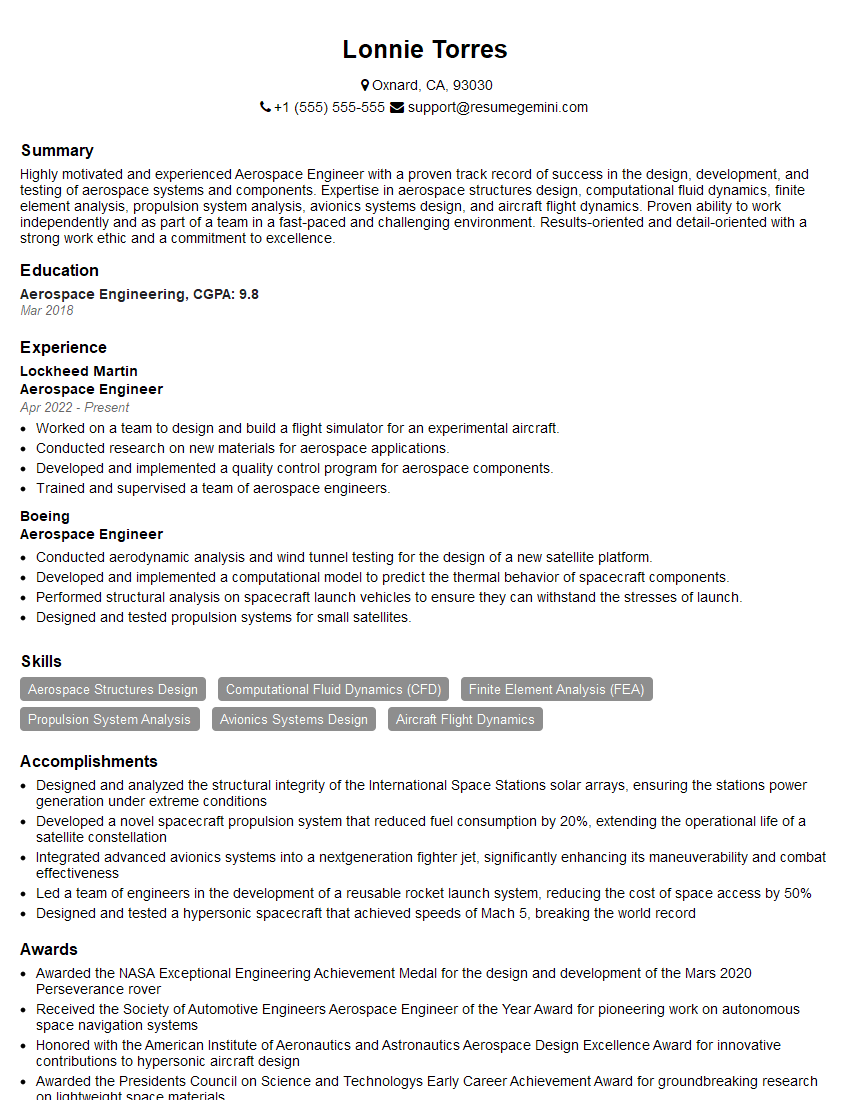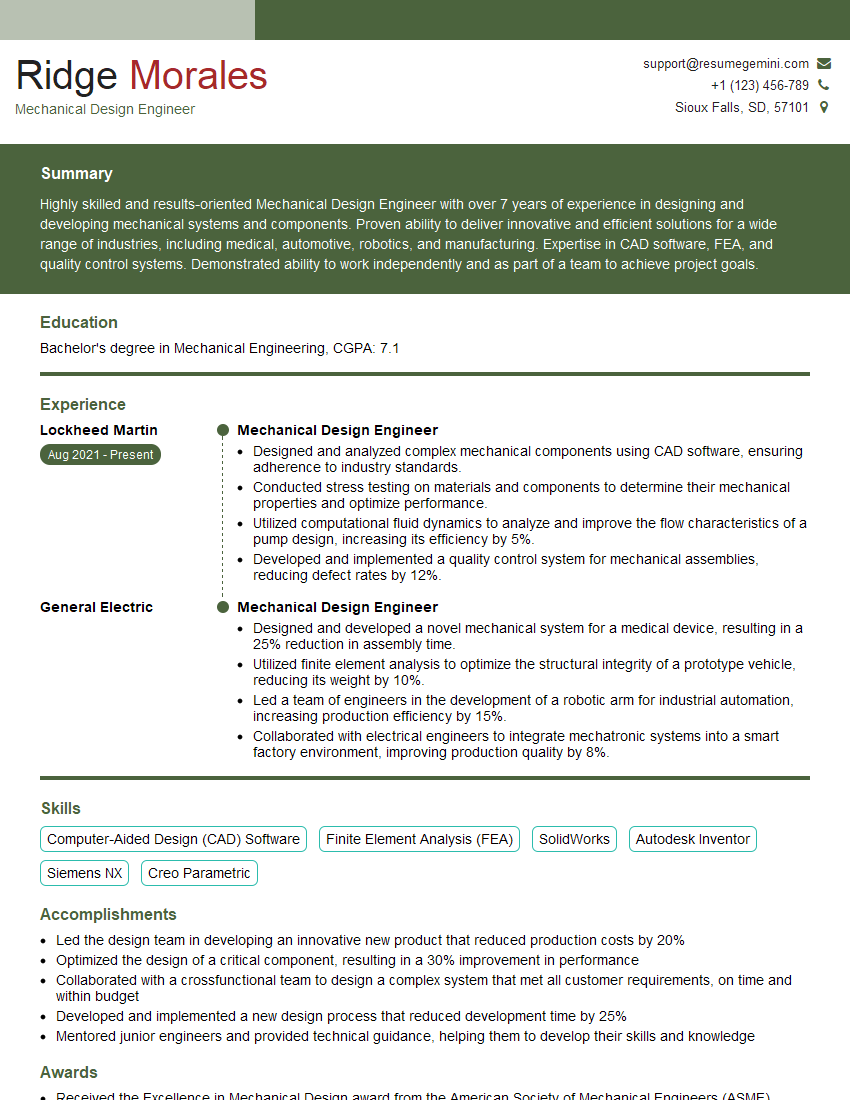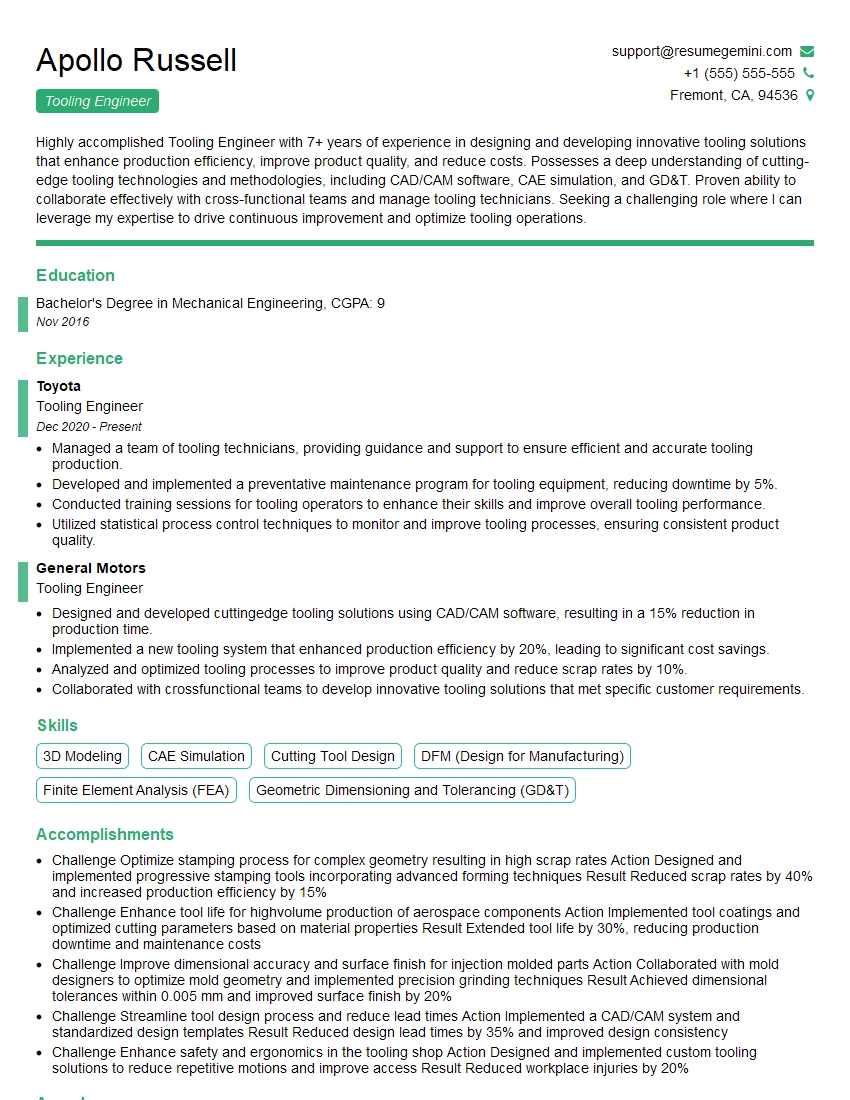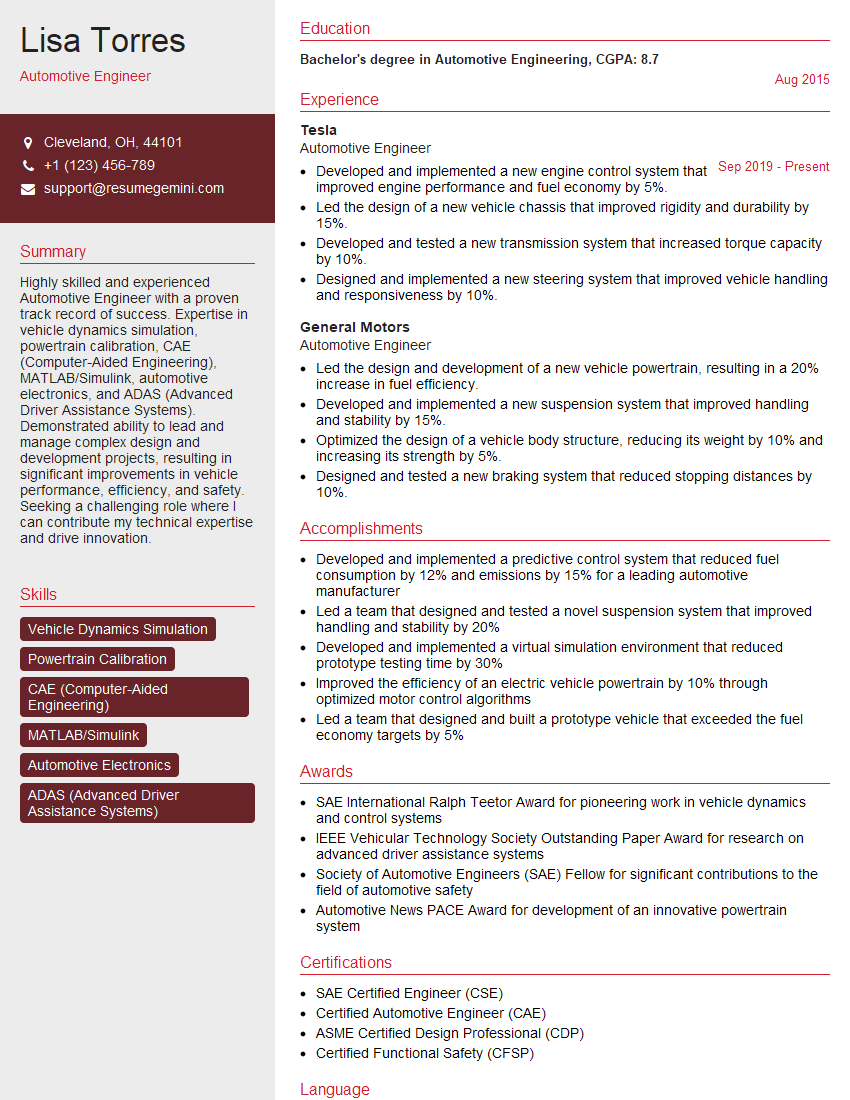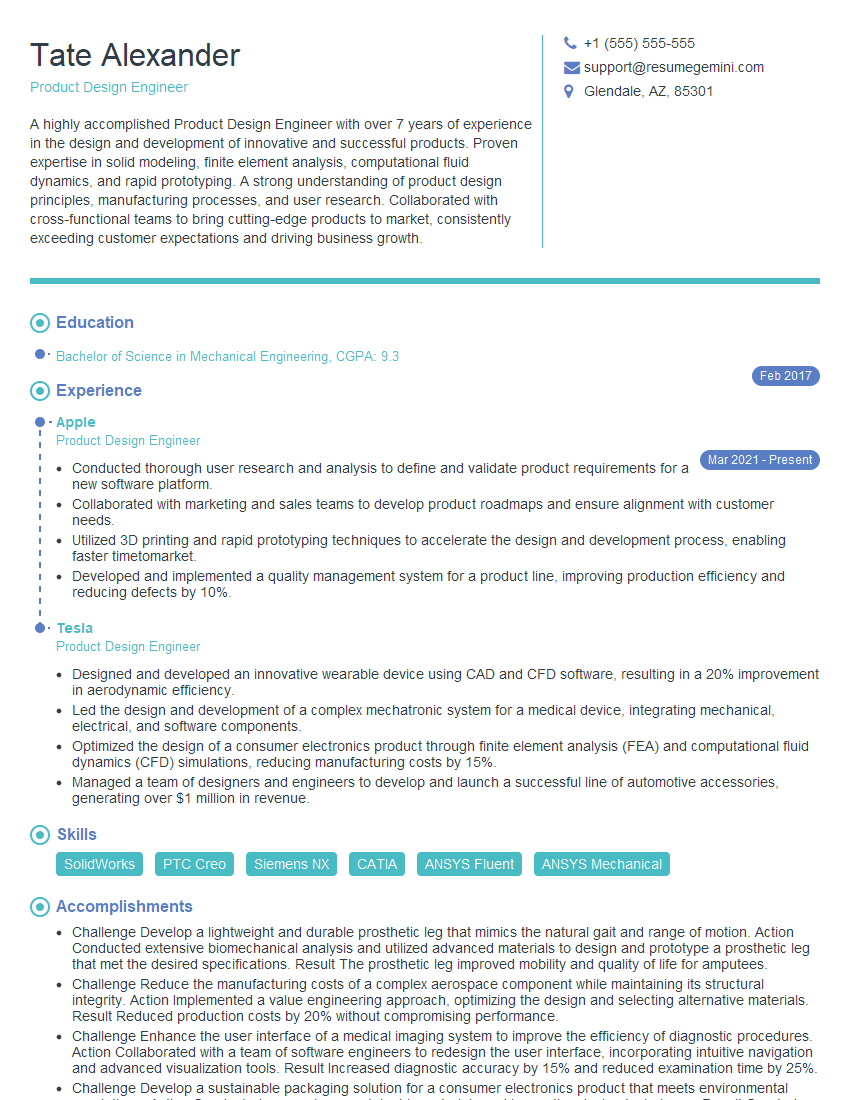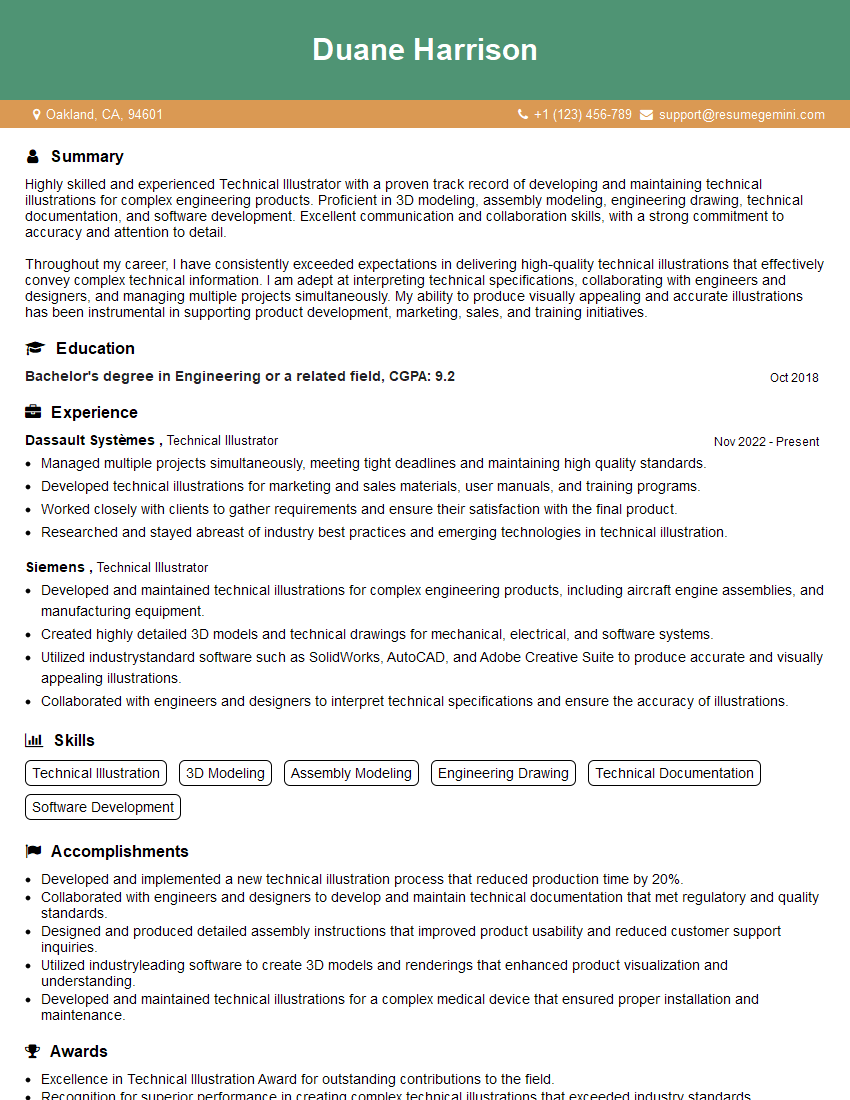Are you ready to stand out in your next interview? Understanding and preparing for American National Standards Institute (ANSI) Y14.5 interview questions is a game-changer. In this blog, we’ve compiled key questions and expert advice to help you showcase your skills with confidence and precision. Let’s get started on your journey to acing the interview.
Questions Asked in American National Standards Institute (ANSI) Y14.5 Interview
Q 1. Explain the difference between Position Tolerance and Orientation Tolerance.
Position tolerance and orientation tolerance are both geometric tolerances that control the location of features, but they focus on different aspects. Think of it like this: position is about the center of a feature, while orientation is about its angle.
Position Tolerance controls the permissible variation in the location of the center point of a feature (like a hole) relative to a datum reference frame. It ensures the feature is within a specified zone around its ideal location. Imagine a target – position tolerance defines the allowable deviation of the hole’s center from the bullseye.
Orientation Tolerance, on the other hand, controls the angular variation of a feature’s axis or plane relative to a datum. It ensures that the feature is not tilted or rotated beyond a specified limit. Using the target analogy, orientation would ensure the target isn’t leaning to one side.
For instance, a shaft might have a position tolerance specifying its center must be within 0.1 mm of a designated point, and an orientation tolerance specifying its axis cannot deviate more than 0.5 degrees from a perpendicular datum.
Q 2. Define the concept of a Feature Control Frame (FCF).
A Feature Control Frame (FCF) is a rectangular box containing all the information needed to define a geometric tolerance. It’s the cornerstone of GD&T (Geometric Dimensioning and Tolerancing) and acts as a concise instruction set for manufacturers. It’s like a recipe for precision.
A typical FCF includes:
- Geometric Characteristic Symbol: Indicates the type of tolerance (e.g., position, perpendicularity, flatness).
- Tolerance Zone Value: Specifies the allowable variation.
- Datum Reference(s): Identifies the datum features used to establish the reference frame.
- Material Modifier (MMC/LMC/RFS): Specifies how the tolerance zone changes depending on the actual size of the feature.
For example: Σ0.1 A | B This indicates a position tolerance of 0.1, referenced to datums A and B. The size and shape of the tolerance zone depend on the material modifier (not specified here).
Q 3. What are the different types of datum references and when would you use each?
Datum references are fundamental to GD&T. They are stable features used to establish a coordinate system for controlling the location and orientation of other features. Think of them as the fixed points of your manufacturing blueprint.
ANSI Y14.5 recognizes several types:
- Primary Datum (A): The most stable and usually the largest feature. Often a flat surface.
- Secondary Datum (B): The second most stable feature, referenced to the primary datum. Could be a hole or another surface.
- Tertiary Datum (C): The third most stable feature, referenced to the primary and secondary datums. This further refines the coordinate system.
The choice of datums depends on the part’s functionality and manufacturing process. For example, a part might use a large, flat surface as its primary datum because it provides the most stable base. Secondary and tertiary datums are then chosen to provide additional reference points, ensuring the final assembly fits and functions correctly.
Q 4. Describe the meaning of MMC and LMC and how they impact tolerance zones.
MMC (Maximum Material Condition) and LMC (Least Material Condition) are material modifiers that describe the size of a feature at its largest and smallest permissible limits, respectively. They significantly influence the tolerance zone.
MMC refers to the condition where a feature has the most material (e.g., a shaft at its largest diameter or a hole at its smallest diameter). When MMC is specified in the FCF, the tolerance zone is its largest size. This means that even if the feature is smaller than its maximum size, it still must stay within that larger tolerance zone. This gives more tolerance for the feature to deviate from its ideal location or orientation.
LMC refers to the condition where a feature has the least material (e.g., a shaft at its smallest diameter or a hole at its largest diameter). Using LMC in the FCF results in the smallest tolerance zone.
For example, a position tolerance might specify MMC for a shaft (giving a larger zone to allow for variations in shaft size) and LMC for the hole it fits in (reducing the allowable position deviation of the hole as it grows in size).
Q 5. Explain the significance of the Material Modifier symbol.
The Material Modifier symbol, often indicated by (MMC), (LMC), or (RFS), in the FCF clarifies how the size of the feature impacts the size of the tolerance zone. It’s crucial because it explicitly links the geometric tolerance to the feature’s size.
Without material modifiers, the tolerance zone remains constant regardless of feature size. Modifiers are important to ensure functional requirements are met across the entire range of permissible feature sizes.
Consider a shaft fitting into a hole. Using MMC for the shaft and LMC for the hole ensures sufficient clearance even at the extremes of manufacturing variation. This avoids interference regardless of feature size variations.
Q 6. What are the different types of geometric tolerances?
ANSI Y14.5 defines numerous geometric tolerances, each addressing specific aspects of a feature’s form, orientation, location, and runout. Some key examples include:
- Form Tolerances: Straightness, Flatness, Circularity, Cylindricity – control the shape of a single feature.
- Orientation Tolerances: Perpendicularity, Angularity, Parallelism – control the angle of a feature relative to a datum.
- Location Tolerances: Position, Concentricity, Symmetry – control the location of a feature relative to a datum.
- Runout Tolerances: Circular Runout, Total Runout – control variations around an axis of rotation.
The selection of the appropriate tolerance depends on the part’s function and the criticality of its geometric characteristics.
Q 7. Explain how to interpret a position tolerance with a datum reference frame.
Interpreting a position tolerance with a datum reference frame involves understanding how the tolerance zone is defined relative to those datums. The datums establish the coordinate system, and the tolerance zone is positioned within that system.
For example, Σ0.1 A | B specifies a position tolerance of 0.1 referenced to datums A and B. This means the center of the feature must lie within a cylindrical tolerance zone with a diameter of 0.2 (twice the tolerance value) that’s centered on the intersection of datums A and B. The orientation of the tolerance zone is established by the datums’ relationship to each other.
The interpretation requires visualizing the datums as reference planes or axes, then positioning the cylindrical tolerance zone based on their intersection. The center of the feature must then fall within this zone. Often, this is easier with a physical model or CAD software to ensure precise understanding and compliance.
Q 8. How are profile tolerances used in engineering drawings?
Profile tolerances, as defined in ANSI Y14.5, control the form of a feature by specifying a tolerance zone within which the entire feature must lie. Unlike traditional tolerances that control individual dimensions, profile tolerances control the overall shape of a feature, be it a surface or a centerline. Imagine trying to fit a car key into a car door. A profile tolerance ensures the entire key’s shape, not just its length and width, fits the keyhole.
They are applied using either a profile of a line (for features like edges or centerlines) or a profile of a surface (for surfaces). The tolerance zone is typically defined by two parallel lines or surfaces separated by the specified tolerance value. Any deviation of the actual feature from the ideal geometry must fall within this zone.
Example: A profile tolerance of 0.1 mm applied to a curved surface means that all points on the actual surface must remain within 0.1 mm of the theoretically perfect surface.
Q 9. Describe the difference between straightness and flatness.
Both straightness and flatness are geometric tolerances that control form deviations, but they apply to different types of features. Straightness controls the deviation of a line element from a perfectly straight line. Think of a perfectly straight arrow. Straightness tolerance specifies how much the actual line can deviate from that ideal straight line. It’s typically used for features like shafts, edges, or axes.
Flatness, on the other hand, controls the deviation of a plane surface from a perfectly flat plane. Think of a perfectly flat tabletop. Flatness tolerance specifies how much the actual surface can deviate from that ideal flat plane. It’s used for surfaces like plates, machine tables, or mating surfaces.
Key Difference: Straightness applies to lines, while flatness applies to planes.
Q 10. How is circularity different from cylindricity?
Both circularity and cylindricity are geometric tolerances assessing the form of features, but they control different aspects of roundness. Circularity controls the roundness of a circular cross-section at a single point along a feature. Imagine a perfectly round coin. Circularity ensures the actual cross-section remains within a specified tolerance of this perfect circle.
Cylindricity, however, controls the roundness and straightness of an entire cylindrical feature over its entire length. It is a more stringent tolerance because it checks both the roundness of every cross-section along the cylinder’s length and the straightness of the cylinder’s axis simultaneously. Imagine a perfectly round and straight rod. Cylindricity ensures that rod’s roundness and straightness over its entire length stay within the given tolerance.
Key Difference: Circularity only checks roundness at a single cross-section, whereas cylindricity checks both roundness at every cross-section and the overall straightness of the cylindrical feature.
Q 11. Explain the concept of runout and its applications.
Runout is a geometric tolerance that controls the total deviation of a feature from a datum axis or datum plane during a single revolution. It combines both circularity and axiality (straightness or position) into a single tolerance. Think of a wheel spinning on an axle. Runout assesses how much the wheel’s surface deviates from the ideal, perfectly concentric rotation about the axle.
There are two types of runout: circular runout, which checks the variation of the circular cross-section from a datum axis, and total runout, which adds the axial variation to the circular variation. This means total runout considers both the radial deviation and the axial deviation of the feature during one revolution.
Applications: Runout is commonly used for features like shafts, rotors, and cylindrical parts where concentricity and axial alignment are crucial. It ensures smooth and consistent rotation and helps prevent vibrations or other issues caused by unevenness.
Q 12. What are the common symbols used in ASME Y14.5?
ASME Y14.5 uses a variety of symbols to represent geometric tolerances and datums. Some common symbols include:
−(Minus sign): indicates a feature control frame.S: StraightnessF: FlatnessC: CircularityCYL: CylindricityR: Runout○: (Datum feature symbol): Indicates a datum reference.M: Material Condition Symbol
These symbols, along with their associated numerical values and datum references, clearly communicate the geometric requirements to manufacturers and inspectors.
Q 13. How do you interpret a Projected Tolerance Zone?
A Projected Tolerance Zone is a tolerance zone that is projected from one surface to another. It’s often used when controlling the relationship between features that are not directly connected. Imagine two parallel surfaces with a gap between them. A projected tolerance zone projects the tolerance from the surface you’re measuring *to* a related surface you aren’t directly measuring.
Interpretation: The tolerance zone isn’t applied directly to the feature but is created by projecting the specified tolerance to the secondary feature’s surface. The feature’s position is checked against the projected zone.
Example: Consider two holes in a part. The Projected Tolerance Zone ensures that the axis of the second hole, relative to the datum features, stays within the specified tolerance zone relative to the first hole’s axis. It essentially maintains the geometric relationship between the two features, even if there’s space between them.
Q 14. Explain the importance of proper datum selection.
Proper datum selection is crucial because it forms the foundational reference for all geometric tolerances. Datums are theoretically perfect geometric features (points, lines, or planes) that serve as a reference for measuring and controlling the location and orientation of other features. The accuracy of all other geometric tolerances and dimensional specifications is directly dependent on how well datums are defined and selected.
Importance: Incorrect datum selection can lead to inaccurate measurements, misinterpretations of tolerances, and ultimately, manufacturing defects. Datums should be chosen based on factors such as stability, measurability, and their relationship to the critical features of the part. In simpler terms: your house needs a solid foundation (datums) before you can build the walls and roof accurately (other features).
Strategy for Selecting Datums: Typically, datums are selected in order of importance to the part’s functionality, usually prioritizing primary datum (A), secondary datum (B), and tertiary datum (C). The choice should be based on functionality, ease of measurement, and manufacturing processes.
Q 15. How do you handle conflicting tolerances on a drawing?
Conflicting tolerances arise when multiple dimensions or tolerances on a drawing contradict each other, leading to ambiguity in acceptable part geometry. ANSI Y14.5 addresses this by establishing a hierarchy of controls. The most restrictive tolerance always governs. For instance, if a feature has both a size tolerance and a position tolerance, and the size tolerance restricts the possible positions more than the position tolerance, the size tolerance prevails. It’s crucial to analyze the drawing carefully to identify the dominant control and ensure it’s properly applied in manufacturing and inspection. This often requires a deep understanding of the design intent, which might necessitate communication with the designer. If the conflict is unresolved through careful analysis, a clarification should be sought from the design authority.
Example: Imagine a hole with a diameter tolerance of ±0.1 mm and a position tolerance of 0.2 mm. If the position tolerance requires the hole center to be within 0.2 mm of a datum, but due to the size tolerance, certain positions within this 0.2mm range are impossible to achieve, the smaller diameter tolerance dictates the actual acceptable range of hole positions.
Career Expert Tips:
- Ace those interviews! Prepare effectively by reviewing the Top 50 Most Common Interview Questions on ResumeGemini.
- Navigate your job search with confidence! Explore a wide range of Career Tips on ResumeGemini. Learn about common challenges and recommendations to overcome them.
- Craft the perfect resume! Master the Art of Resume Writing with ResumeGemini’s guide. Showcase your unique qualifications and achievements effectively.
- Don’t miss out on holiday savings! Build your dream resume with ResumeGemini’s ATS optimized templates.
Q 16. Describe the differences between unilateral and bilateral tolerances.
Unilateral and bilateral tolerances describe how much variation is allowed from a nominal (target) dimension. A bilateral tolerance specifies an equal amount of permissible variation above and below the nominal value. For example, a ±0.1 mm tolerance means the actual dimension can be between 9.9 mm and 10.1 mm if the nominal size is 10mm. A unilateral tolerance, on the other hand, allows variation only in one direction from the nominal. For instance, a 10.0 +0.2 mm tolerance means the actual dimension can range from 10.0 mm to 10.2 mm, with no tolerance permitted below 10.0 mm. The choice between unilateral and bilateral tolerances depends on the design requirements; unilateral tolerances are often used when variation in one direction is more critical than in the other. For example, a shaft fitting into a hole might benefit from a unilateral tolerance to ensure sufficient clearance.
Q 17. How does GD&T affect manufacturing processes?
Geometric Dimensioning and Tolerancing (GD&T) profoundly influences manufacturing processes. Instead of simply specifying dimensions with tolerances (which only address size), GD&T defines the allowable variation in form, orientation, location, and runout of features. This clear communication of requirements helps manufacturers:
- Select appropriate manufacturing methods: Knowing the precise geometric requirements helps determine the necessary machining processes, tooling, and fixturing to achieve the desired accuracy and control.
- Optimize processes for efficiency: By understanding the tolerances allowed, manufacturers can avoid over-processing and save time and materials.
- Improve product quality and consistency: GD&T provides a common language for design and manufacturing, minimizing misinterpretations and reducing the incidence of rejected parts. Clear tolerances ensure parts meet specifications consistently.
- Reduce inspection time and costs: With clear requirements, inspection can be streamlined, focusing on critical characteristics defined by GD&T.
Example: A positional tolerance on a hole not only specifies size but also how far the hole’s center can deviate from its ideal location. This is crucial information for CNC machining setup and inspection. Using GD&T, a manufacturer can choose a less precise and more cost-effective process that still ensures that the part meets functionality requirements.
Q 18. Explain the benefits of using GD&T in product design.
Using GD&T in product design offers several key advantages:
- Improved communication: GD&T provides a standardized language, minimizing ambiguity between designers, manufacturers, and inspectors. This reduces errors and misunderstandings.
- Enhanced product functionality: By explicitly defining functional requirements, GD&T ensures that parts fit and function as intended, even with some dimensional variation. This reduces costly rework and improves the reliability of assembled products.
- Optimized designs for manufacturing: GD&T promotes designs that are easier and more cost-effective to manufacture, by allowing manufacturers to choose the most suitable methods.
- Reduced costs: The combination of improved communication, efficient manufacturing, and less rework results in significant cost savings throughout the product lifecycle.
- Increased product quality and reliability: Clearer specifications lead to consistent part quality, reducing assembly problems and improving product performance and lifespan.
Example: Specifying a profile tolerance on a curved surface using GD&T guarantees the surface form regardless of size variation, ensuring proper function even with slight deviations in overall dimensions.
Q 19. What software tools are commonly used to create and interpret GD&T drawings?
Many software tools support the creation and interpretation of GD&T drawings. These range from dedicated CAD (Computer-Aided Design) software packages to specialized GD&T analysis programs. Commonly used CAD packages include:
- Autodesk Inventor: Offers robust GD&T tools directly within the modeling environment.
- SolidWorks: Provides comprehensive GD&T capabilities, enabling creation and analysis of complex models.
- Creo Parametric: A powerful CAD system with extensive features for GD&T definition and verification.
For GD&T analysis, some dedicated software packages perform tolerance stack-up analysis and other simulations to verify the design meets functional requirements.
Q 20. How do you ensure the proper application of GD&T in a production environment?
Ensuring proper GD&T application in production requires a multi-faceted approach:
- Comprehensive training: All personnel involved—designers, manufacturers, and inspectors—need thorough training in ANSI Y14.5 principles. This ensures everyone understands and applies GD&T consistently.
- Clear documentation: GD&T specifications must be clearly documented on drawings and in associated documents. This includes not only the GD&T symbols but also clear explanations of the intended function and acceptable variations.
- Robust quality control processes: Inspection procedures should be developed to effectively verify that parts meet the GD&T requirements. This often involves using coordinate measuring machines (CMMs) and other precision measuring instruments.
- Regular audits and reviews: Periodic audits ensure compliance with the GD&T standards and identify any areas needing improvement in the process.
- Communication and collaboration: Open communication between design, manufacturing, and inspection teams is vital to ensure consistent interpretation and application of GD&T specifications.
Using a structured approach and well-defined procedures is crucial for consistently applying GD&T in a production setting. Continuous improvement initiatives help to identify areas for refinement to improve manufacturing efficiency and minimize rejects.
Q 21. What are some common mistakes to avoid when using GD&T?
Common mistakes to avoid when using GD&T include:
- Overlooking the datums: Datums are fundamental to GD&T, providing the reference points for measurements. Failure to properly define and control datums leads to inconsistent interpretations and potentially flawed parts.
- Improper tolerance selection: Choosing inappropriate tolerances can lead to over-tight or overly loose specifications, affecting both manufacturing cost and product functionality.
- Ignoring tolerance stack-up: The cumulative effect of tolerances on multiple features must be considered to ensure the assembled product meets functional requirements. Failure to do so can result in assembly issues.
- Poor communication: Lack of clarity in GD&T specifications, especially in complex assemblies, can cause misunderstandings between designers and manufacturers.
- Insufficient training: Improperly trained personnel may misinterpret or misapply GD&T symbols and principles, leading to errors in design and manufacturing.
Careful planning, thorough training, and a well-defined process are crucial to mitigate these common mistakes and ensure the successful implementation of GD&T.
Q 22. Explain the relationship between GD&T and dimensional inspection.
Geometric Dimensioning and Tolerancing (GD&T), as defined in ASME Y14.5, and dimensional inspection are inextricably linked. GD&T provides the language for specifying the permissible variation in a part’s geometry, while dimensional inspection provides the method for verifying that the part conforms to these specifications. GD&T uses symbols and tolerances to define allowable deviations from a perfect geometric form, size, orientation, location, and runout. Dimensional inspection, using various tools like CMMs (Coordinate Measuring Machines), calipers, and micrometers, then measures the actual part to see if it falls within these defined tolerances. Think of GD&T as the blueprint, and dimensional inspection as the quality control process ensuring the blueprint is followed.
For example, a drawing might specify a hole’s position using a Position tolerance zone. Dimensional inspection would then use a CMM to measure the actual hole’s position, verifying if it falls within the specified tolerance zone. Failure to meet the GD&T specifications indicates that the part is non-conforming.
Q 23. How do you communicate effectively with manufacturing personnel regarding GD&T requirements?
Effective communication with manufacturing personnel about GD&T requires a multi-pronged approach. First, avoid relying solely on complex technical jargon; instead, use clear, concise language and visuals. Training is paramount. Workshops or training sessions focusing on the basics of GD&T, including hands-on exercises, significantly improve understanding. Visual aids such as annotated drawings and 3D models showing acceptable and unacceptable variations are extremely helpful. Regular communication channels, including meetings and progress reports, are crucial to address any emerging questions or concerns. Crucially, focus on the functional implications of GD&T requirements—how the tolerances impact the part’s performance and assembly—to make the connection more tangible for manufacturing personnel.
For instance, instead of saying “The Position tolerance is 0.1 mm,” you might say, “This hole needs to be within 0.1 mm of its intended location to ensure proper mating with the mating part. If it’s outside that, the assembly won’t function correctly.”
Q 24. How do you stay updated on the latest changes and revisions to ASME Y14.5?
Staying updated on ASME Y14.5 requires proactive engagement. The most reliable way is to subscribe to the ASME (American Society of Mechanical Engineers) and receive notifications of updates and revisions. Regularly reviewing the latest edition of the standard is vital. Attending industry conferences and workshops related to GD&T keeps you abreast of best practices and emerging interpretations. Networking with other GD&T professionals through professional organizations and online forums provides insights and allows you to share experiences and learn from others’ challenges and solutions. Keeping up with relevant articles and publications in engineering journals and industry news also contributes to maintaining a current understanding of the standard.
Q 25. What is the significance of feature control frames (FCFs) in 3D CAD modeling?
Feature Control Frames (FCFs) are fundamental to 3D CAD modeling because they directly translate GD&T requirements into the digital design. In CAD software, FCFs are not just annotations; they are active constraints defining the allowable variation of geometric features. This allows for early detection of design errors and facilitates automated inspection planning. By incorporating FCFs during the design phase, designers can ensure that the model reflects the intended tolerances and facilitates the creation of inspection plans, which in turn, help prevent costly errors during manufacturing.
For instance, adding a Position FCF to a hole in a CAD model will ensure that any changes made to the model remain within the specified tolerance. The software can then check for violations during the design process.
Q 26. Explain how GD&T principles apply to different manufacturing methods (e.g., casting, machining).
GD&T principles adapt to various manufacturing processes. In machining, GD&T directly controls the tolerances achievable with machining operations. For example, a positional tolerance on a machined hole ensures the hole is accurately located. In casting, GD&T accounts for the inherent variations in the casting process, specifying tolerances that accommodate shrinkage and other process-related imperfections. For example, a larger tolerance on a cast feature might be specified to reflect the higher variability associated with casting. Similarly, in sheet metal forming, GD&T considers the effects of bending and stretching on part dimensions and flatness. The choice of specific GD&T controls depends on the manufacturing process capabilities and the required functional performance of the part. It’s about matching the rigor of the GD&T specification to the capabilities of the manufacturing method.
Q 27. How would you interpret and apply a simultaneous requirement in a feature control frame?
A simultaneous requirement in a Feature Control Frame (FCF) means that multiple geometric characteristics must be controlled simultaneously. This differs from sequential requirements where the tolerances are considered independently. A common example is a simultaneous requirement for position and circularity. It means that the circularity of the feature must be maintained while also considering the position of the feature. In other words, the tolerance zone for position is applied to the center point of the actual circular feature, not just an ideal mathematical point.
For example, Σ0.1 −0.05 Pos; Cir would simultaneously control the position and circularity of a feature. The position tolerance zone is 0.1, and the circularity tolerance is -0.05 (meaning the diameter must be at least 0.05 smaller than the nominal diameter to avoid the tolerance zone being exceeded).
Q 28. Describe a situation where you had to resolve a GD&T-related issue on a project. (Focus on technical details, not behavioral aspects).
On a recent project involving the design of a precision pump assembly, a conflict arose between the design intent and the manufacturability of a critical shaft. The design called for a tight tolerance on the shaft’s straightness (a form control), specified using a straightness tolerance zone of 0.02mm. The manufacturing team, however, faced difficulty achieving this precision using the specified machining process. Analysis revealed that the straightness tolerance was overly restrictive for the chosen material and manufacturing process. The solution involved revising the straightness tolerance to 0.05mm based on a process capability study, while maintaining the shaft’s functional requirements through careful consideration of its interaction with other components. This involved confirming that the increased tolerance still maintained acceptable runout in the assembled pump.
Key Topics to Learn for American National Standards Institute (ANSI) Y14.5 Interview
- Geometric Dimensioning and Tolerancing (GD&T): Understand the fundamental principles of GD&T and its application in engineering drawings. Focus on the core concepts and their practical implications for manufacturing and inspection.
- Datums and Datum References: Master the selection and establishment of datums, including their importance in defining feature relationships and controlling part variations. Practice applying datum principles to various scenarios.
- Tolerancing Methods: Become proficient in interpreting and applying various tolerancing techniques, including size, form, orientation, location, runout, and profile tolerances. Understand the impact of different tolerance types on part functionality.
- Feature Control Frames (FCFs): Gain a solid understanding of FCFs, their components, and how they’re used to specify tolerances and control feature relationships. Practice interpreting complex FCFs on technical drawings.
- Material Condition Modifiers: Learn how material condition modifiers affect the interpretation of GD&T symbols and the overall tolerance zone. Understand their influence on inspection and part acceptance.
- Symbolic Representation and Interpretation: Develop proficiency in accurately interpreting and sketching engineering drawings that incorporate GD&T. Be prepared to explain the meaning of various symbols and their positional significance.
- Practical Applications in Manufacturing: Prepare to discuss how GD&T principles affect manufacturing processes, quality control, and inspection techniques. Understand the relationship between design intent and manufacturing feasibility.
- Problem-Solving with GD&T: Practice solving problems that involve interpreting GD&T specifications, identifying potential issues, and proposing solutions based on your understanding of the standards.
Next Steps
Mastering ANSI Y14.5 is crucial for career advancement in engineering and manufacturing, demonstrating a strong understanding of precision and quality control. An ATS-friendly resume is essential for getting your application noticed. To significantly improve your job prospects, leverage ResumeGemini to craft a compelling and effective resume that showcases your Y14.5 expertise. ResumeGemini provides examples of resumes tailored to highlight ANSI Y14.5 skills, helping you present your qualifications in the best possible light. Take the next step and build a resume that opens doors to exciting career opportunities.
Explore more articles
Users Rating of Our Blogs
Share Your Experience
We value your feedback! Please rate our content and share your thoughts (optional).
What Readers Say About Our Blog
Hello,
We found issues with your domain’s email setup that may be sending your messages to spam or blocking them completely. InboxShield Mini shows you how to fix it in minutes — no tech skills required.
Scan your domain now for details: https://inboxshield-mini.com/
— Adam @ InboxShield Mini
Reply STOP to unsubscribe
Hi, are you owner of interviewgemini.com? What if I told you I could help you find extra time in your schedule, reconnect with leads you didn’t even realize you missed, and bring in more “I want to work with you” conversations, without increasing your ad spend or hiring a full-time employee?
All with a flexible, budget-friendly service that could easily pay for itself. Sounds good?
Would it be nice to jump on a quick 10-minute call so I can show you exactly how we make this work?
Best,
Hapei
Marketing Director
Hey, I know you’re the owner of interviewgemini.com. I’ll be quick.
Fundraising for your business is tough and time-consuming. We make it easier by guaranteeing two private investor meetings each month, for six months. No demos, no pitch events – just direct introductions to active investors matched to your startup.
If youR17;re raising, this could help you build real momentum. Want me to send more info?
Hi, I represent an SEO company that specialises in getting you AI citations and higher rankings on Google. I’d like to offer you a 100% free SEO audit for your website. Would you be interested?
Hi, I represent an SEO company that specialises in getting you AI citations and higher rankings on Google. I’d like to offer you a 100% free SEO audit for your website. Would you be interested?
good




